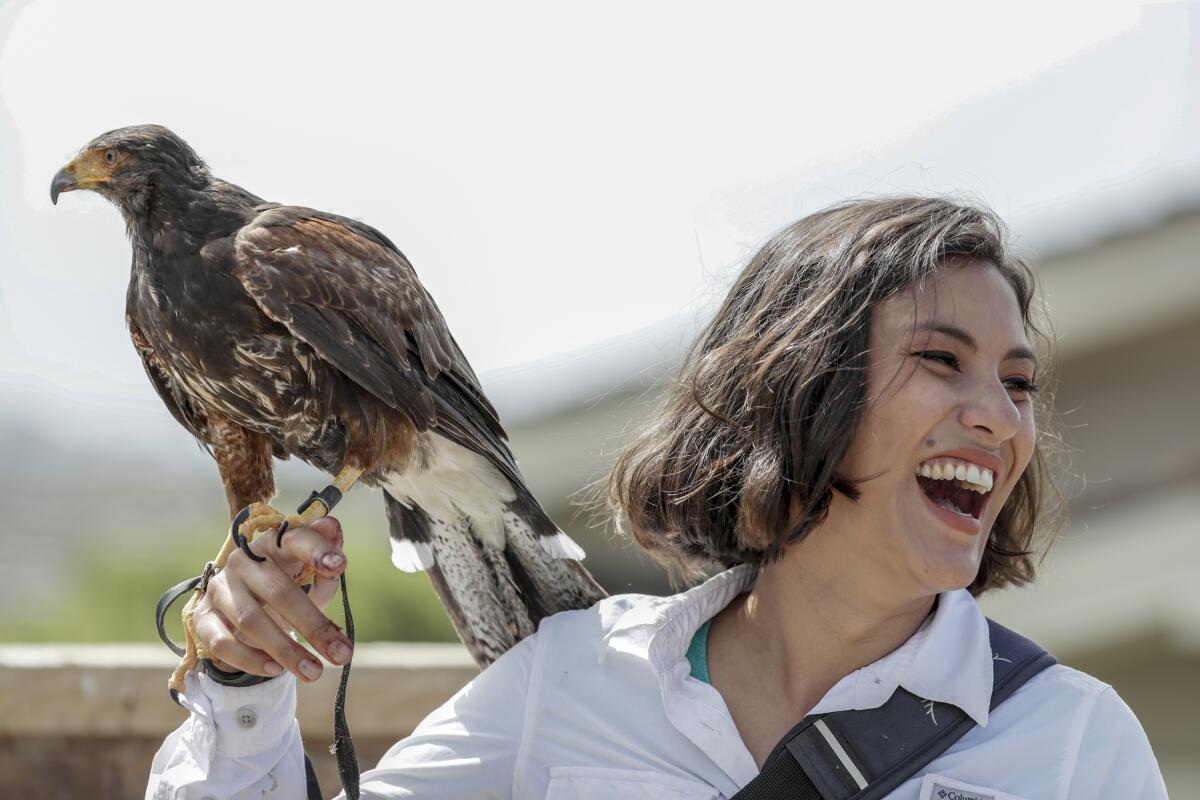Calling in the ‘bird mafia’ to intimidate pesky pigeons and seagulls

- Share via
Perched on a second-floor balcony, Floyd surveyed his dominion: the sparkling turquoise-blue pool below him, the steaming hot tub to the left, the bar and grill to his right and the red-tiled roofs of the posh Montage Laguna Beach resort at his back.
From this vantage point, the sharp-talon Harris’s hawk kept an eye out for pesky seagulls, blackbirds and pigeons that make a mess on the roofs and steal food from guests lounging by the pool. His job was to harass the infiltrators, letting them know they weren’t wanted. The brown hawk spread its wings and silently swooped from the balcony, skimming a pool umbrella before landing on the gloved hand of its trainer.
“It’s a predator-prey relationship that has been going on for centuries,” said Adam Chavez, a master falconer who has been employed for more than six years by the Montage to keep the 30-acre resort free of flying pests with the help of some winged muscle.
“We are the winged security,” Chavez said. “We are like the bird mafia.”
The sport of falconry dates back thousands of years but only in the last decade or so has it become more common to see birds of prey employed in the nuisance abatement trade. In California, dozens of falconers have turned the ancient pastime into business ventures used by an increasing tally of resorts, airports, farms and office buildings.
In 2007, the U.S. Fish and Wildlife Service started approving permits that allow predatory birds to be used for commercial ventures. Since then, it has approved 137 active permits to use hawks, falcons and other predators for bird abatement, with 43 of those permits in California.
In an era of increasing environmental concern, hotel operators and building owners say they prefer deploying hawks and falcons instead of bird repellent, spikes, nets or fake owls to keep pigeons, seagulls and other birds from defecating, nesting or stealing food from guests and tenants.
“To the guests, when they have French fries by the pool and a seagull steals them, that’s where the rubber hits the road.”
— Lynn Mohrfeld, California Hotel and Lodging Assn.
“We realize maintaining this program for the long term is the most eco-friendly way to curb the presence of nuisance birds, ensuring all our outdoor areas remain pleasant for all our guests and patrons,” said Montage Laguna Beach’s general manager, Anne-Marie Houston.
Trained hawks and falcons have been especially popular for keeping seagulls away from seaside resorts, such as the Hotel Del Coronado near San Diego and Terranea Resort in Rancho Palos Verdes.
They have also been used further inland to ward off pigeons and grackles from locations including U.S. Bank Tower in downtown L.A., the Los Angeles County Museum of Art and the JW Marriott Desert Springs Resort & Spa.
Falconers in the Los Angeles area charge about $65 an hour, according to operator estimates, with costs rising up to $1,000 a day depending on the number of birds and handlers needed.
By keeping seagulls and pigeons away, the hawks and falcons save hotels and landlords the cost of cleaning up bird excrement and nests. But Lynn Mohrfeld, president of the California Hotel and Lodging Assn., said the biggest problem with nuisance birds is the annoyance factor.
“To the guests, when they have French fries by the pool and a seagull steals them, that’s where the rubber hits the road,” he said.
Farmers who grow grapes, berries and cherries in the Napa and Sonoma valleys have also used professional falconers to protect their crops. One of Chavez’s clients is a landfill that is often swarmed by seagulls.

The use of the predator birds has become so popular that Vahe Alaverdian, owner of Falcon Force, a California-based bird abatement company, said he has more job offers than his staff of 26 employees and 60 falcons and hawks can handle.
“It’s an environment where you can’t do anything else,” he said of bird abatement. “Everything is about being sustainable and green.”
But not everyone supports the idea of using the trained hawks and falcons for commercial use.
“There is a lot of traditional falconers out there that have concerns about it,” said Sheldon Nicolle, president of the North American Falconers Assn., a group with about 2,000 members, most of whom train predator birds for hunting. He estimates that only 200 to 300 of those members use their birds for commercial abatement.
“Falconry is not something you pursue for profits,” Nicolle said. Traditional falconers raise and train hawks and falcons to hunt sage grouse, ducks, prairie chickens, squirrels and jackrabbits among other creatures, he said.
Still, Nicolle acknowledged that the use of falcons and hawks for bird abatement helps to educate the public about the predator birds, especially when they are used in public places where falconers often draw a flock of curious onlookers.
“I’ve always said abatement could be falconry’s best friend or worst enemy,” he said.
To ensure commercial falconers don’t take falcons and hawks from the wild for such businesses, the U.S. Fish and Wildlife Service issues permits only to falconers who use captive-bred birds for commercial purposes.
On a recent Friday morning, Roxanne Word, a falconer who works for Chavez, fed Floyd chunks of meat as a reward for swooping over the pool and perching on the roof of the Montage resort. Within a few minutes of taking Floyd out of his box, several guests stopped to watch the hawk in action, taking photos with their smartphones.
Alain Hirtz and his son Michael, tourists from Montreal, stopped by the pool to get a closer look.
“The bird is beautiful,” said Alain Hirtz. “It seems like an ecological and beautiful alternative.”

Professional falconers like Chavez say they don’t deploy the hawks and falcons to kill or harm nuisance birds. The trained birds simply need to swoop around a resort, hotel or orchard long enough to send the message that the property is the domain of a predator.
The hawks and falcons have made themselves such a presence at the Montage that crows seem to fly away the moment Chavez and his crew pull up to the resort’s parking lot.
When he first started working at the Laguna Beach resort, Chavez deployed his hawks and falcons every day to chase off seagulls and pigeons. Now, he needs to fly a couple of hawks around the property only three days a week to remind the nuisance birds that the resort is off-limits.
Chavez first fell in love with predator birds when he was 12. His father owned mining property near Carson City, Nev., where Chavez came across three young kestrel falcons that appeared to be abandoned. With the blessing of state fish and game officials, he said he raised one of the birds and later passed an exam to be a falconer.
Chavez eventually turned his love of falconry into a business that now employs 15 people and 30 hawks and falcons. His birds wear GPS devices on their backs so they can be tracked, but usually a chunk of quail or rabbit meat is all that is needed to tempt the predators back to their handlers.
The number of falconers who provide bird abatement services is still so small that Chavez said he knows most of his competitors.
And the rivalry is friendly. When a professional falconer goes on vacation, Chavez said, another is happy to swoop in and patrol the territory.
More to Read
Inside the business of entertainment
The Wide Shot brings you news, analysis and insights on everything from streaming wars to production — and what it all means for the future.
You may occasionally receive promotional content from the Los Angeles Times.











